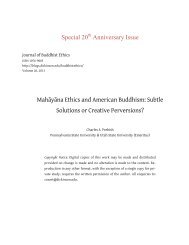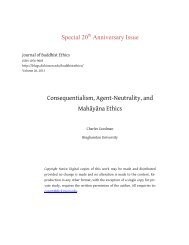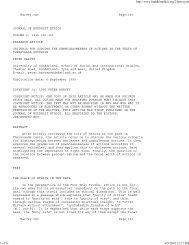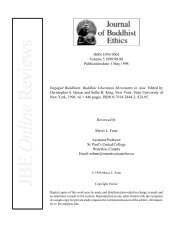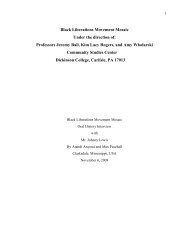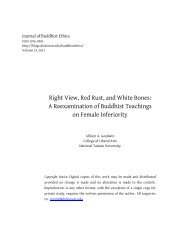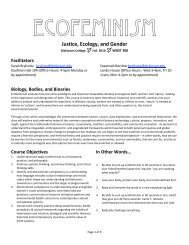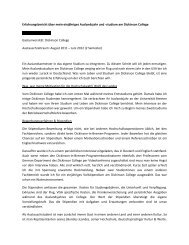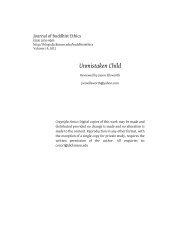Epstein, Dreams of Subversion INTRO ... - Dickinson Blogs
Epstein, Dreams of Subversion INTRO ... - Dickinson Blogs
Epstein, Dreams of Subversion INTRO ... - Dickinson Blogs
You also want an ePaper? Increase the reach of your titles
YUMPU automatically turns print PDFs into web optimized ePapers that Google loves.
6 <strong>Dreams</strong> <strong>of</strong> <strong>Subversion</strong> in Medieval jewish Art and Literature<br />
hypothetical Jewish artist still stands, though it may now be directed at the ostensible<br />
Jewish patron: Why did the Jewish patron request particular scenes, iconography,<br />
and symbols?<br />
Yet we cannot so blithely sidestep the question <strong>of</strong> the illuminator's identity.<br />
When one examines the presuppositions <strong>of</strong> the arguments made in favor <strong>of</strong> Christian<br />
illuminators, they turn out to be based primarily upon stylistic evidence : a<br />
division <strong>of</strong> labor in manuscript production , we are told, might have resulted in<br />
the coupling <strong>of</strong> a text obviously written by a Jew because <strong>of</strong> its language with<br />
illuminations " obviously" created by a Christian becaus e <strong>of</strong> their style.<br />
Now, it is true that there is little ground for the assumption that a particular<br />
manuscript must have been illuminated by Jews simply because the language <strong>of</strong><br />
its text is Hebrew. But, the necessary (and seldom-considered) corollary to such<br />
an assertion is that, in the absence <strong>of</strong> specific documentary evidence <strong>of</strong> the back <br />
ground <strong>of</strong> the illuminator, there is likewise no rea son to assume that a particular<br />
Hebrew manuscript was illuminated by a Christian because its stylistic "language"<br />
is that <strong>of</strong> the dominant majority. There is a nefarious tendency to pre <br />
suppose that manu scripts exhibiting style, and in some cases, iconography characteristic<br />
<strong>of</strong> their time and place could not, a priori, have been illuminated by<br />
Jews. Even when, as is <strong>of</strong>ten the case, one encounters iconography in Hebrew<br />
illuminated manuscripts that contains details that suggest familiarity wit h midrash<br />
or commentary, it has become customary, on the basis <strong>of</strong> style alone, to<br />
propose that Christian artists simply copied this Jewish iconography, perhaps<br />
from an ancient Jewish iconographic tradition now lost. But if one conjectures<br />
Christians cop ying Jewish iconography, might one not just as easily postulate<br />
Jewish artists who emulated Christian style? Both are possible, and the issue has<br />
not yet been conclusively resolved.<br />
Still, if we are to maintain that there is something indigenously "Jewish" about<br />
medieval Jewish art, the problems posed by Christian illuminators, even if working<br />
under a Jewish patron, remain complex, though not insurmounta ble. For instance,<br />
if one wishes to argue that medieval Jewish illumination is fra ught with<br />
subversive iconography, does it not seem necessary that the art sho uld have been<br />
the literal product <strong>of</strong> Jewish hands? It is difficult to fathom how Christian illuminators<br />
would have tolerated being commissioned to create th e kind <strong>of</strong> illum inations<br />
I sha ll discuss in the following chapters, images that contain indigeno usly<br />
Jewish messages <strong>of</strong> protest and dreams <strong>of</strong> subversion direc ted aga inst Christian<br />
culture. Yet why, realistically, does it seem so implausible th at a Christian illuminator<br />
would have limned an image hostile to Christian society unawares, when<br />
it is so easy to imagine oblivious Jewish illuminators heed lessly adopting iconographic<br />
motifs from Christian art? The symbols I shall parse were, after all, common<br />
and fairly pervasive emblems whose indigenously Jewish meaning is not<br />
always immediately clear without some prior knowledge <strong>of</strong> Jewish texts and<br />
"If lions could carve stones .. ." 7<br />
traditions. Such symbols may very well have been requested by Jewish patrons<br />
from Christian artisans unaware <strong>of</strong> their latent protestant or subversive content.<br />
Third, and finally, even in the unlikely event that patrons were not involved at<br />
all and that Christians created the iconography entirely on their own, it must be<br />
recalled that the actual and intended audience for medieval Hebrew manu scripts<br />
was Jewish; we must consider not only the genesis, but the possible reception <strong>of</strong><br />
the illumination as well. We can ask the same question <strong>of</strong> that audience that we<br />
asked <strong>of</strong> the ostensible Jewish illuminator and patro n: Regardless <strong>of</strong> its origin,<br />
how might this iconography have been "read" by a medieval Jewish audience?<br />
Ultimately, it is clear th at medieval Jewish art is Jewish not because it was produced<br />
by Jews, but because it was produced forJews-Jewish patrons and Jewish<br />
audi ences. But to accept this idea is not so simple as it seems. It necessitates making<br />
a quantum leap fro m the opinion that medieval Jewish art is derivative and<br />
superficial to an encounter with medieval Jewish art as inherently Jewish. This<br />
leap, in turn, forces upon us th e mantl e <strong>of</strong> inter pre tation. N o longer is the simple<br />
knowledge <strong>of</strong> the occurrence <strong>of</strong> transcultural borrowing or <strong>of</strong> the process by<br />
which it occurs sufficient . Such knowled ge leaves us hungerin g for more infor <br />
mation. We need to know to wh at end the borrowing was effected. The tradition<br />
al view <strong>of</strong> the medieval Jewish iconographic tradition "fro m the outside in"<br />
req uires corrective balance.P<br />
One thing is certain: Jews did no t commiss ion or create art in a vacuum. Scholars<br />
<strong>of</strong> medieval art have assidu ously catalogued examples <strong>of</strong> " the image <strong>of</strong> the<br />
Jew" as reflected in "the mirror <strong>of</strong> Christian art." Thi s research has revealed an<br />
<strong>of</strong>ten gro tesque body <strong>of</strong> material illuminating the otherness <strong>of</strong> the Jews, from the<br />
perspective, <strong>of</strong> course, <strong>of</strong> the majority culture.' >Thi s gallery <strong>of</strong> horrors in fact<br />
formed the backdrop against which subversive elements flouri shed in Jewish art<br />
<strong>of</strong> the thirteenth and fourteenth centuries. Such elements existed in a symbiotic<br />
relationship with the perception and reception <strong>of</strong> the Jews in the majority culture<br />
and its art. They stood minimally in reac tion to, and maximally in response to,<br />
"the image <strong>of</strong> the Jew in the mirror <strong>of</strong> Christian art ."<br />
It is necessary to investigate wh at recourse Jews in the Middle Ages might have<br />
had to express their self-perceptions, to depict their neighbors, and to depict<br />
themselves vis-a-vis their neighbors in their own art, particularly if those neighbors<br />
were polemicizing against them in literature and art. Until we address these<br />
issues, the conceptual shift from a very general perception <strong>of</strong> Jewish art as outside<br />
the mainstream to an active definition <strong>of</strong> Jewish art as the art <strong>of</strong> a minority culture,<br />
with all the atten dant fascin ations and methodological difficulties <strong>of</strong> such a<br />
definition, will remain a desideratum. I explore those complex but signa l issues in<br />
the chapters to come. I shall demonstrate throughout what it means to " borr ow"<br />
iconography, and consider what may be revealed about medieval Jewish culture<br />
by th e ways in which medieval Jews borrowed it. Wh y did Jews borrow specific



